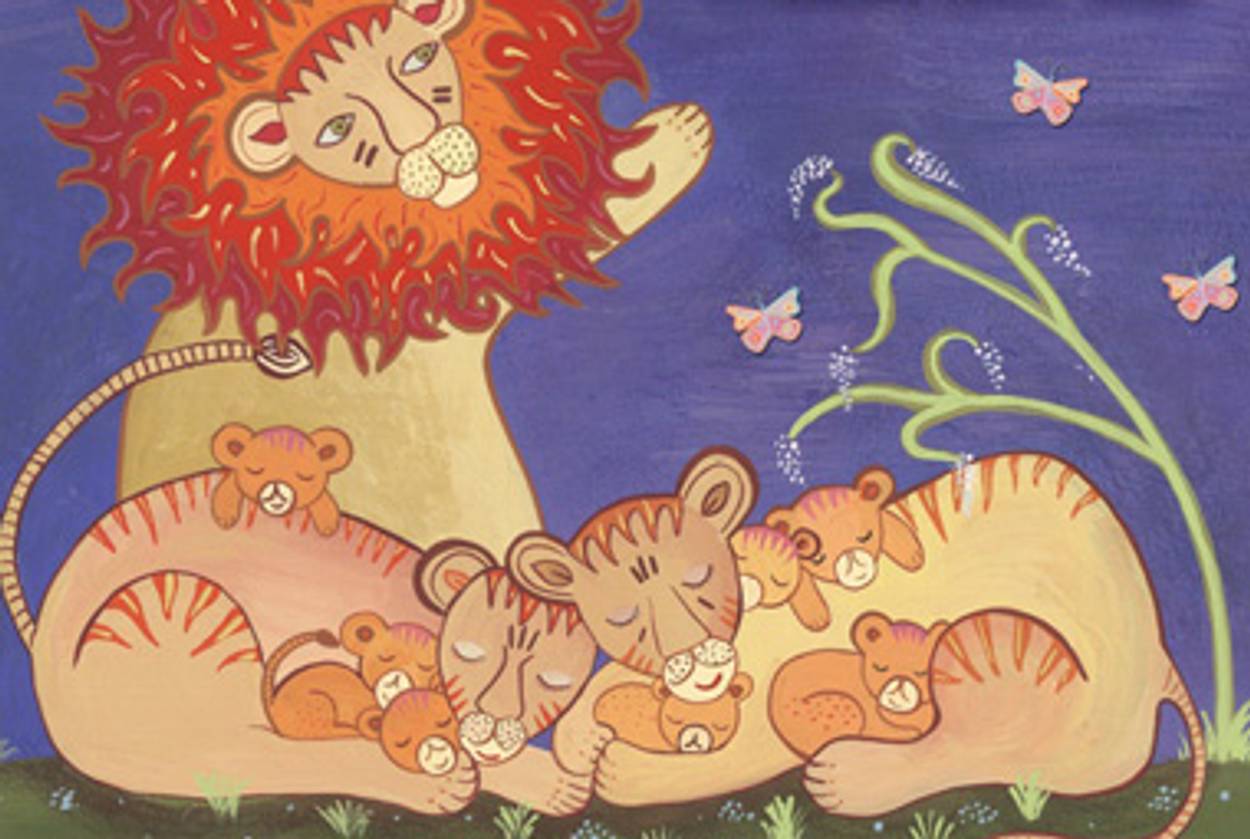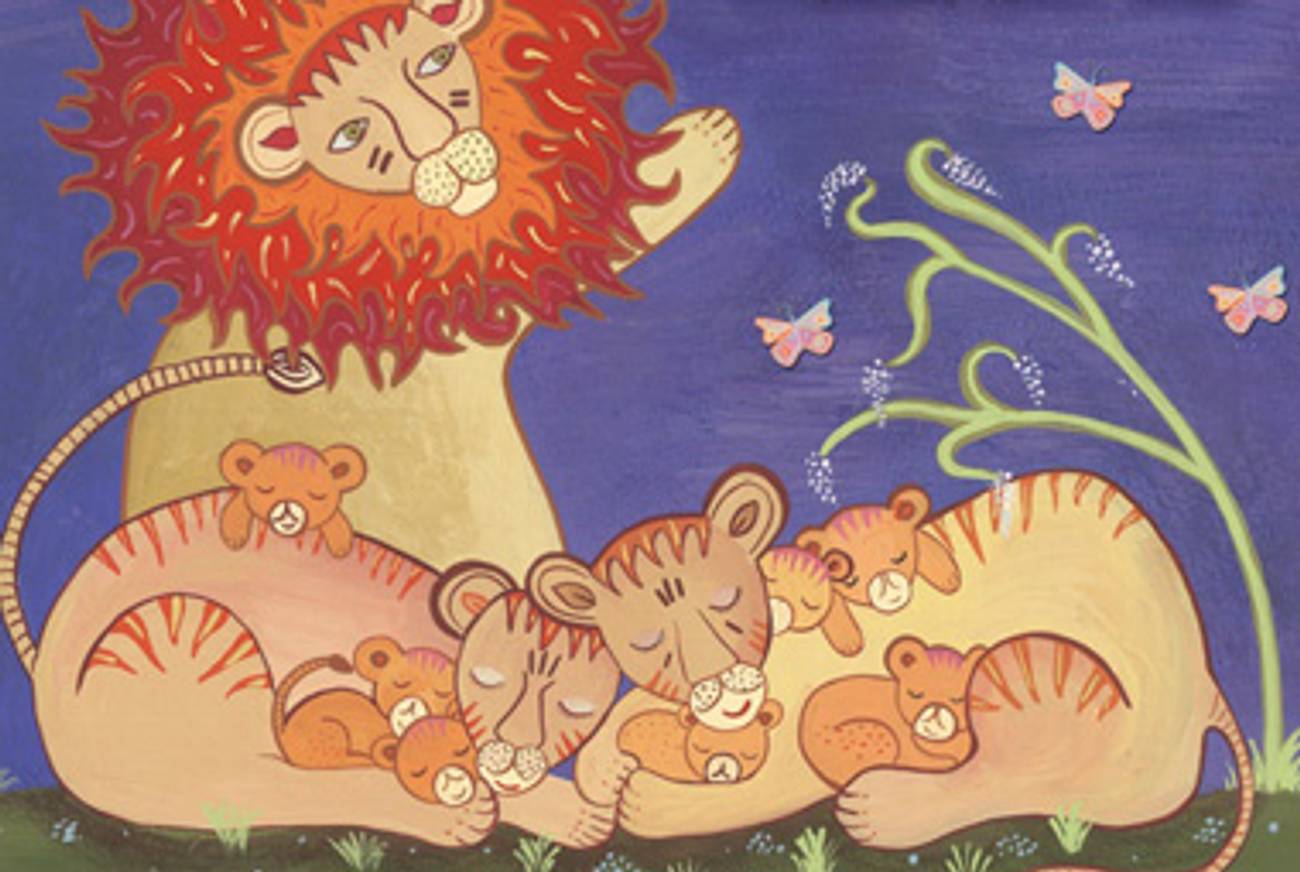Great Kids’ Books
The best Jewish picture books of 2009




Here are my favorite picture books of the year. Next week we’ll look at chapter books. Sorry, no board books—this year either I didn’t love them or I didn’t deem them sufficiently Jewy. (But if you wanna pick up Happy Hanukkah, Corduroy, knock yourself out.)
New Year at the Pier: A Rosh Hashanah Story by April Halprin Wayland, illustrated by Stéphane Jorich (Dial Books for Young Readers). This is my pick for the best Jewish picture book of the year. It’s about Tashlich. It’s funny; it’s moving; it’s lyrical; there’s good dialogue. Best of all, it shows how hard apologizing can be, and how cathartic. The protagonist, Izzy, is a credible little kid—he apologizes to his sister for drawing on her forehead while she’s asleep. I like the fun , vaguely French watercolor illustrations, with lots of yummy detail in the kids’ clothes—Stéphane Jorisch has a way, in particular, with shoes. (And I like that Cantor Livia and her guitar-playing accompanist, with their flowy Berkeley-vibed clothing, look like a specific and familiar breed of middle-aged bobo Jewess.) This book is superb. (Grades K-3)
When I First Held You: A Lullaby from Israel by Mirik Snir, illustrated by Eleyor Snir (Kar-Ben). “Rain tapped a song/ Rocks rolled along/ The sea waved with glee/ When I held you close to me.” The words are simple but sweet; for me, the folk art-y, naïve paintings are what really make the book. (Mirik Snir should be shepping serious nachas from her artist daughter.) Brightly colored, curvy images of lots of animal parents and babies cuddling make a soothing yet unboring (blessedly pastel-free) read for little ones. There’s a quote in Hebrew and English at the end, from Rabbi Nachman of Bratslav: “The day you were born is the day God decided that the world could not exist without you.” And there’s a place at the back to place your child’s photo and birthdate. What kid wouldn’t feel safe and special when this book was read to him? (Infant to Grade 1)
The Yankee at the Seder by Elka Weber, illustrated by Adam Gustavson (Tricycle). This book is based on the true story of a Civil War-era Southern Jewish family that invited a passing Northern Jewish soldier to Passover dinner, only a day after General Robert E. Lee’s surrender. Uh-oh. The family’s 10-year-old son, Jacob, is horrified to have a “Yankee Jew” in attendance. He’s grieving the end of the war and the loss of his dreams: “I was never going to be a Rebel general. I’d never capture a whole unit of Yankees single-handed.” The tensions at the seder table are both uncomfortable and exciting. Jacob’s father pointedly tells the soldier that the message of the haggadah is that “no man needs to submit to the tyranny of an evil government;” the soldier, Myer Levy, says that the Passover story is about “how no man wants to be a slave and about how wonderful it is to be free.” Differences are put aside for the meal, but no one hugs it out at the end. “Well, that was something, wasn’t it?” is all the mom can come up with afterward. The book is illustrated with luscious, dark-toned oil paintings. There’s a historical note and photos at the end, but the book doesn’t feel at all like boring school stuff. (Grades 2-4)
The Champion of Children: The Story of Janusz Korczak by Tomek Bogacki (FSG/Foster). This is another book that sounds like a noble, virtuous, narcolepsy-inducing history lesson—the spinach of Jewish juvenilia. Yet of all the books on this list, this one is by far my daughter Josie’s favorite. (She’s eight.) Korczak grows up in Warsaw, encounters anti-Semitism, pledges to fight for children’s rights, goes to medical school, starts an orphanage for Jewish children in which the kids help govern themselves and create a just society. Josie loved that last part. The book is beautifully illustrated, with acrylic paintings that have a slightly skewed, just-barely-cartoonish perspective. Some paintings stand alone while others are tiny spot illustrations integrated into the text. There’s so much to look at. And at the end, when Korczak’s children are marched from the Warsaw ghetto to the train that will take them to their deaths in Treblinka, there’s so much to mourn. I still think Lois Lowry’s Number the Stars is a better introduction to the idea of the Holocaust, but this is a gorgeous, gently-told book that every Jewish kid should eventually read. (Grades 2-4, and for adults, too)
Faith by Maya Ajmera, Magda Nakasis, and Cynthia Pon (Charlesbridge). This photography book illustrates how different cultures around the world pray, read sacred books, eat, visit holy places, celebrate festivals, and mark lifecycle events. Some kids love to look at photos of other kids, and this book will hypnotize them. There’s very little text. The images celebrate diversity without bludgeoning anyone over the head with it. We see a Jewish girl making challah with her zayde, a young Buddhist novice meditating, Nigerian children praying together, a bar-mitzvah boy chanting the Torah, a Muslim family breaking the daily fast during Ramadan, a Guatemalan kid with missing front teeth grinning broadly in an Easter mask. Charming. (Pre-K to Grade 4)
You Never Heard of Sandy Koufax?! By Jonah Winter, illustrated by André Carrilho. (Schwartz & Wade, $17.99) Many years ago, as a tiny Jew, I got sick of hearing about Sandy Koufax. Whenever a kid would say there aren’t any great Jewish athletes, some grownup would trot out the story of a guy a million years ago who sat out a World Series game because it fell on Yom Kippur. To which we tiny Jews said (in our tiny heads): big whoop. Our unasked question: how much did that guy’s teammates and all the fans want to kill him? It sure didn’t sound Good for the Jews, refusing to play in the World Series. Will today’s tiny Jews also be resistant to hearing about how Sandy Koufax was awesomely Jewish and noble (there’s that word again)? Not if this book can help it. It’s enticing even without the nobility angle. There’s a crazy moving 3-D holographic cover image of Koufax mid-pitch. The illustrations are cool and distorted and freaky—and there’s a lot of brilliant gold leaf in them. Koufax is all arcing-curving-curve-ball-throwing giant arms, plus a set of bushy eyebrows. He’s pure power. He’s an enigma. The unnamed teammate who narrates this book (in a folksy voice that could possibly be deemed annoying) doesn’t really understand him, and we don’t either. But the fact that the main character feels elusive is OK. We respect his hard work, the way he faces anti-Semitism, the way no one can figure out what motivates him when he suddenly quits baseball at his peak. We end up just admiring the guy’s individuality; that’s better and truer than hagiography. Sometimes questions are richer than answers.(Grades 1-4)
When I Wore My Sailor Suit by Uri Shulevitz (Farrar, Straus & Giroux). This book, for very young kids, is a little snippet of one of Shulevitz’s childhood memories. Little Uri visits the Mintzes’ apartment and plays with a model ship on a dresser, imagining himself on a daring voyage where he meets a pirate and finds a treasure map. But he’s pulled out of his fantasy by a painting in the room: a portrait with creepy eyes that seem to follow him. At first Uri is too freaked out to continue his imaginary play, but eventually he finds a way to defeat the picture’s scariness and go back to his world-sailing fantasy. Shulevitz is a heavy hitter in children’s books—he won a Caldecott Medal in 1969, for The Fool of the World and the Flying Ship, and has illustrated nearly 40 books (including Isaac Bashevis Singer’s astounding—and shockingly out of print—1982 retelling of The Golem). Last year’s How I Learned Geography is a more Serious, Important autobiographical book—that one, for slightly older children, addressed more directly Shulevitz’s childhood in World War II-era Warsaw (where his apartment was hit by a bomb in 1939, while he was home) and his family’s flight to Paris, Turkmenistan, and then Israel. Mid-journey, the father can’t afford food at a desert market, and instead comes home with a map, which turns out to offer its own kind of nourishment in terrible times. Both books are about the power of storytelling and imagination. The illustrations in When I Wore My Sailor Suit are warmer and more inviting than the ornate, sweeping vistas Shulevitz paints in How I Learned Geography. They’re cozy. And the story deals with addressing fear in an authentic, manageable way. Maxine, age five, adores it. (Pre-K to Grade 2)
Next week: the year’s best chapter books.
Marjorie Ingall is a columnist for Tablet Magazine, and author of Mamaleh Knows Best: What Jewish Mothers Do to Raise Successful, Creative, Empathetic, Independent Children.
Marjorie Ingall is a former columnist for Tablet, the author of Mamaleh Knows Best, and a frequent contributor to the New York Times Book Review.